The Improbable Voyage of the Capricornio
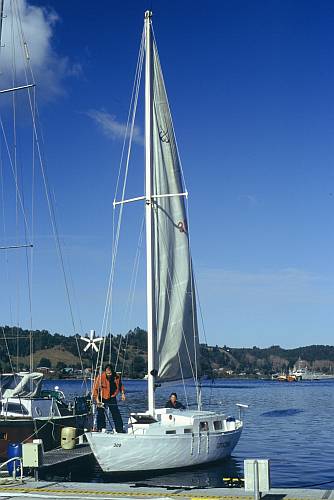 It was in mid winter
2004 when my friend and then workmate Germán invited me to sail
to the Comau fjord aboard his yacht Capricornio. You will understand that
at first I was a bit reluctant to go, considering that the summer before,
on the boat's and the Captain's first trip in the complicate waters of
Chiloé, more than one thing went wrong, with no electricity of any
sort on board, no radio contact, no lights, no bilge pump, the boat taking
on water like mad, the hand pump breaking down, the mast almost going overboard
when the forestay broke, and a few dozen other interesting happenings of
the kind that add spice to the seaman's life.. But then, errhm, I
thought that these nice fellows would not survive another trip without
my valuable help, and said yes!
It was in mid winter
2004 when my friend and then workmate Germán invited me to sail
to the Comau fjord aboard his yacht Capricornio. You will understand that
at first I was a bit reluctant to go, considering that the summer before,
on the boat's and the Captain's first trip in the complicate waters of
Chiloé, more than one thing went wrong, with no electricity of any
sort on board, no radio contact, no lights, no bilge pump, the boat taking
on water like mad, the hand pump breaking down, the mast almost going overboard
when the forestay broke, and a few dozen other interesting happenings of
the kind that add spice to the seaman's life.. But then, errhm, I
thought that these nice fellows would not survive another trip without
my valuable help, and said yes!
Before starting the trip, Germán sent me a big box with the
Capricornio's whole electronic outfit: VHF radio, autopilot, depht finder, etc.
It was all out of order, and my assignment was to fix it all before we
began the trip. Germán had sent the bad generator for professional
repair, so at least we would have assured electricity. I fixed all the
stuff as best I could. When something is brutally corroded by thirty years
at sea, there's only so much one can do!
The Capricornio was built mostly by Germán's father, starting
in the early seventies, and construction took many years. Germán
basically grew up on it, knows it inside and out, and recently bought it
to keep it in the family. Poor Capricornio had spent several years getting
less maintenance than necessary, which explains all the trouble on the
first trip.
I arrived by plane in Puerto Montt, where the Capricornio was waiting,
the evening before we would set sail. Germán and Michael, the third
in the group, would arrive the next morning, and it was my duty to "take
possession" of the yacht, check that all was right in it, and go buy the
groceries in the early morning, so we could weigh anchor as soon as the
two arrived.
The flight was interesting, because the weather was very foul. The Boeing
bounced around, I knocked my head on the side despite the safety belt,
and the landing was with nearly zero visibility in a true Puerto Monttian
rain. This city is famous for it, and a slogan says Puerto Montt, where
the rain turns into song. Walking ten steps from the airport hall to
the bus was enough to get me soaked. Once downtown, I took a taxi to the
marina, and when I arrived there, it was already pitch black night, but
it had miraculously stopped raining! I introduced myself to the marina's
administrator, who assured me that it had rained in this way, almost nonstop,
for the last three months. When I explained that I wanted to board the
sloop Capricornio, he looked funnily and said: "I presume you mean the
Submarine
Capricornio?"
Well, it wasn't that bad after all! It was still afloat, even if just
a little. The bilge pump had failed again, and knowing that the owner was
coming, the marina people had left it that way so we could fix it ourselves.
So the guy brought me to the boat, said good night, and left. And there
I was, inside a perfectly dark, perfectly unknown boat, hunting for a
light switch and finding none. Knowing that there were enough flashlights
on board, I didn't bring my own, and now I regretted that. After much tapping,
bumping my head into unidentified obstacles of all sorts, I finally found
a switch, but nothing happened when I flipped it. I kept feeling for something,
anything,
that would be so kind and give me a few photons, but first managed to get
my feet and shoes soaked, because there was water rising above the floor.
Then I found something that felt like a box of matches. Great! But they
didn't light - they were totally soaked in the extreme humidity! The search
continued, and the next promising object that turned up was a flashlight
- but without batteries.
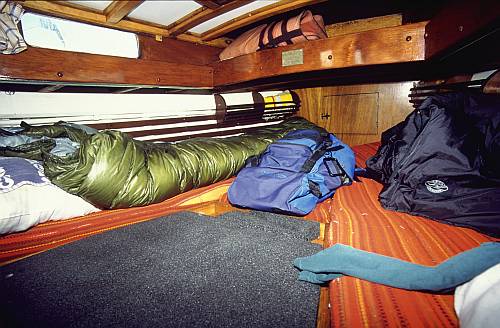 Opening
my path into the bow cabin, I found another flashlight. It was heavy, which
meant that this one actually had batteries. Marvelous! But it didn't
work either... So, the problem could be the batteries, the bulb, or a contact.
I crawled back, found the other flashlight again, put the batteries of
the second one into the first, and Eureka, I had light!!!
Opening
my path into the bow cabin, I found another flashlight. It was heavy, which
meant that this one actually had batteries. Marvelous! But it didn't
work either... So, the problem could be the batteries, the bulb, or a contact.
I crawled back, found the other flashlight again, put the batteries of
the second one into the first, and Eureka, I had light!!!
Armed with a weak but functional flashlight, I found an electrical panel,
with all main switches in OFF position. I switched them all on. Still no
cabin lights. Then I found a panel voltmeter, showing accurately zero Volts.
Either the batteries were flat, or there was a main switch somewhere.
Only after taking off the engine compartment covers and following the wires, did
I find this switch, conveniently hidden in a place nobody would ever find
it, if he hadn't the good idea to check the cable runs! I threw that big
switch, and Eureka squared, now I did have functional cabin lights!
The next thing was lifting some floor boards, and diving for the bilge pump.
After getting as wet as one possibly can, in the icy and dirty bilge soup,
I found it and brought it up. Fortunately the problem was minor: The pump
had eaten little fibers from a frayed line, and these had jammed it. I
cleaned it, reinstalled it, combed the bilge for debris, found the rotten line
and fished it out, and then the pump started working and pumped the bilge
empty. The Submarine Capricornio majestically rose out of the water and
became a real yacht!
My first duty done, I went to sleep. Fortunately my sleeping bag was dry,
but the mattress below was not. Actually, nothing that had been in the
boat was dry, an effect of the continuous rain and the water in the bilge,
which kept the relative humidity as close to 100% as it can get! It rained
most of the night, but in my goose down sleeping bag I was warm and comfortable.
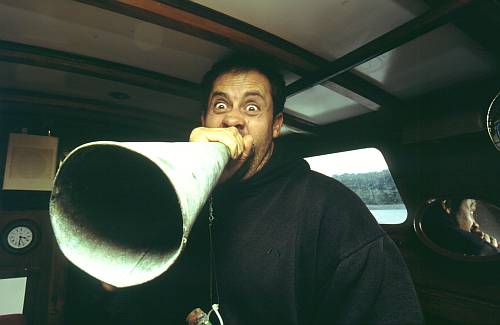 It's
time for an introduction: This is the much bespoken Germán. From
now on we will respectfully call him "the Capt'n". Here he is showing his
impressive ability to give orders. The other main actor of this story,
Michael, will be often referred to as "The Intrepid Boatswain". You will
soon see why, so don't ask.
It's
time for an introduction: This is the much bespoken Germán. From
now on we will respectfully call him "the Capt'n". Here he is showing his
impressive ability to give orders. The other main actor of this story,
Michael, will be often referred to as "The Intrepid Boatswain". You will
soon see why, so don't ask.
Actually, we met at the supermarket, where I was still choosing food
when the two arrived downtown. That was great, because there was no way
I could have carried two big carts worth of stuff to the marina! Even
for three, it was a lot of work. You may know that I'm not the kind of
guy who likes eating noodles and rice day in, day out, so I planned a better
diet, with lots of vegetables, good cheese, fruit, several different sorts
of bread, all kinds of stuff to put on it, fine herbs, good olive oil,
an assortment of fine wines, and a long etc. When the two guys came, they
mostly agreed with my purchases, but added about three quarters of a cow,
cut into convenient chunks. I'm not much of a meat-eater, but these two
sure are!
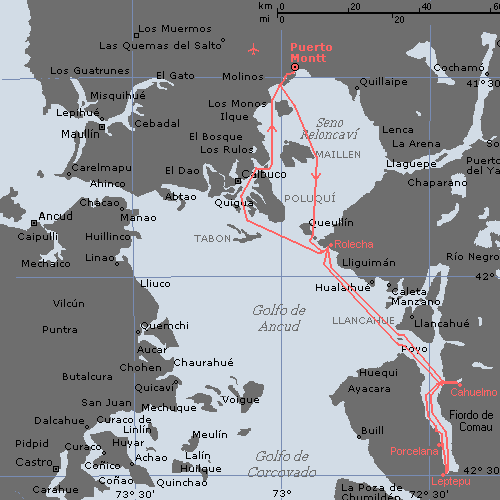 We threw all the
purchases into the sloop, set sail and sailed out on the Tenglo channel,
then straight south across the Reloncaví bay. This map, artfully
drafted by fellow sailor Alfonso Gonzales for this story, shows the area and
a rough sketch of our trip. Basically, we went south to the Comau fjord,
and then along all its length, visiting the beautiful places along it, and
taking refuge in sheltered bays during the nights.
We threw all the
purchases into the sloop, set sail and sailed out on the Tenglo channel,
then straight south across the Reloncaví bay. This map, artfully
drafted by fellow sailor Alfonso Gonzales for this story, shows the area and
a rough sketch of our trip. Basically, we went south to the Comau fjord,
and then along all its length, visiting the beautiful places along it, and
taking refuge in sheltered bays during the nights.
If you are somewhere in this large round world and you have no idea where to
find this on your world map, look for Chile first (that's in South America,
just in case :-), then look where the country starts dissolving into water
roughly at 42 degrees southern latitude. That's the place.
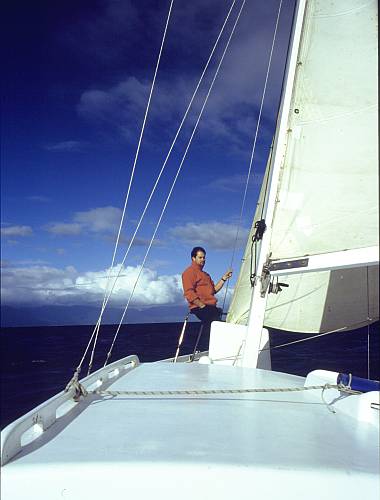 It had stopped
raining, the sun had come through, the wind was perfect, and we enjoyed
it. Most of the time I would sit at the helm. The Capt'n loves to hang
out at the bow, so that's what he did most of the time. Michael, instead,
is the kind of guy who can't stay put for more than five minutes. He was
milling around, stowing away our supplies, cleaning up, cooking, fixing
things, reading the map, navigating, and so on. Sometimes I tried
to switch places with him - but I didn't last! I have an easily upset stomach,
and when the vessel rolls and pitches like it loves to do when the wind comes
from near the stern, like here, I must stay on deck and look at the horizon,
or I would soon feed the fish. And so, if I have to stay on deck anyway,
I might as well hold the helm...
It had stopped
raining, the sun had come through, the wind was perfect, and we enjoyed
it. Most of the time I would sit at the helm. The Capt'n loves to hang
out at the bow, so that's what he did most of the time. Michael, instead,
is the kind of guy who can't stay put for more than five minutes. He was
milling around, stowing away our supplies, cleaning up, cooking, fixing
things, reading the map, navigating, and so on. Sometimes I tried
to switch places with him - but I didn't last! I have an easily upset stomach,
and when the vessel rolls and pitches like it loves to do when the wind comes
from near the stern, like here, I must stay on deck and look at the horizon,
or I would soon feed the fish. And so, if I have to stay on deck anyway,
I might as well hold the helm...
I was a bit worried about the batteries. When we weighed anchor, they
were at only 11.5 Volt, which means they were deeply discharged. The Capricornio
has a solar panel, but in the very bad weather all the previous months
the panel had been pretty useless. Now it was generating a little, but
not nearly enough. Remember this was in winter, days were short, nights
very long. So I suggested to run the engine despite the good wind, just
to charge the batteries. So we did. But an hour later I was shocked to
see that the batteries, far from charging, had dropped to 11.2 Volt! Once
again the engine compartment covers came off, and I crawled in, armed with my
multimeter. The Capt'n throttled up until almost bursting the old engine,
to no avail: The freshly and "professionally" repaired generator was as
dead as an old doornail!
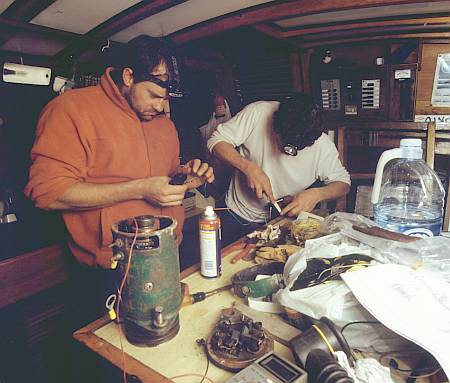 We sailed all
the way to Rolecha, a small village along a bay that offers good anchoring
ground and some protection. Soon the evening came, and on this photo you
can see how our first idyllic night on the Capricornio went: Working with
battery-powered headlamps to conserve the little remaining charge on the
main batteries, the whole crew is at work. The Boatswain was happily filing
away at a fitting he needed to complete an ultra-effective pump setup.
After the last trip, where he got duly fed up with hauling buckets, he
now wanted several pumps in good working order. The Capt'n is assisting
that noble effort, while I'm entirely devoted to the generator.
We sailed all
the way to Rolecha, a small village along a bay that offers good anchoring
ground and some protection. Soon the evening came, and on this photo you
can see how our first idyllic night on the Capricornio went: Working with
battery-powered headlamps to conserve the little remaining charge on the
main batteries, the whole crew is at work. The Boatswain was happily filing
away at a fitting he needed to complete an ultra-effective pump setup.
After the last trip, where he got duly fed up with hauling buckets, he
now wanted several pumps in good working order. The Capt'n is assisting
that noble effort, while I'm entirely devoted to the generator.
This generator isn't a simple thing: It was born in the glorious times
when alternators were inexistent, and when manufacturers had noticed that
an engine needs a generator only while it's running, and a starter only
while it is not yet running, and that it would thus be a brilliant
money-saving idea to combine both functions in a single machine! This contraption
is called a dynastarter, and is basically a four-pole compound motor
designed as a compromise, that does rather mediocre duty as a starter,
and then delivers equally mediocre performance as a dynamo.
This guy was working well as a starter, but not at all as dynamo. A
thorough inspection brought up no immediately obvious problems. The resistances
all seemed normal, the brushes were not marvelous but OK. Then I had a
bright idea. Yes, I do have them from time to time, so don't laugh. I removed
the rotor from the machine, dug out my little pocket compass, which fits
inside the stator, and used it to measure the remnant magnetic field, noting
down which poles were north and which were south. Then, using a battery
taken from a flashlight, I applied some current to the series field winding.
As expected, the magnetic field intensified. Then I applied the battery
to the shunt field winding. Flop! The compass needle turned all the way
around! The north poles had become south poles! Bingo! The idiot who "professionally"
repaired this dynastarter had connected the shunt field backward! So this
machine would have needed to work in one rotation sense as a starter, and
in the opposite sense as a generator... Not very clever indeed! :-)
I had brought a 12 Volt soldering iron aboard, but it was a small one,
for electronic purposes. I could not unsolder and resolder the field connections
with it. So I cut some wires, spliced them as best I could to reverse the
shunt field, and then the Capt'n reinstalled his dynastarter, with open
cover and dangling wires.
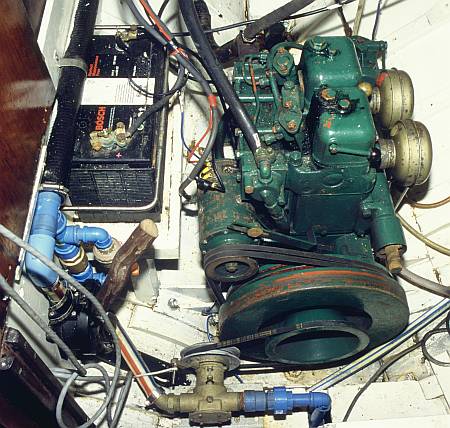 When we started
the engine, the generator came to life, and delivered a huge current, much
larger than it should... Obviously the regulator, one of those old-style
electromechanical things, wasn't working very well. It did regulate, in
some way, but at a much too high level. So we regulated the generator output
via the engine throttle... We left the engine running for a good while,
watching with big smiles how the battery voltage climbed, and soon came
into the green range. This pretty much saved the trip! Actually the Capricornio
can sail without electricity, as it did in summer, but in winter that's
even more uncomfortable. Oil lamps of Aladdin's tradition give only so
much light, and don't power a VHF radio very well...
When we started
the engine, the generator came to life, and delivered a huge current, much
larger than it should... Obviously the regulator, one of those old-style
electromechanical things, wasn't working very well. It did regulate, in
some way, but at a much too high level. So we regulated the generator output
via the engine throttle... We left the engine running for a good while,
watching with big smiles how the battery voltage climbed, and soon came
into the green range. This pretty much saved the trip! Actually the Capricornio
can sail without electricity, as it did in summer, but in winter that's
even more uncomfortable. Oil lamps of Aladdin's tradition give only so
much light, and don't power a VHF radio very well...
The engine is an ages-old Volvo Penta two cylinder diesel. It delivers
impressive 15 HP, which isn't very much for a 9-meter sloop that weighs
four tons. But at least it was running very well, so well that we came
to call it the only reliable component of the Capricornio! Its trademark
propp-propp-propp
sound
instilled an enormous confidence!
This engine has an interesting history: It spent some time on the sea
floor, after its first vessel sank in a storm. It was rescued, repaired,
and installed in the then new Capricornio. Here it ran for many years,
then spent some years sleeping, then it was overhauled and on this trip
it worked like new. And a great feature is that it can be started with
a crank, if necessary! But that requires a guy with real muscles! Many
people can't even start to move it!
If you are surprised by the odd air filters, don't be: They were borrowed
from two Citroën 2CV! The Capt'n is crazy for those equally historic
cars...
The array of pipes and things in the foreground and left is mostly Michael's
work. The brass device is a Jabsco high flow pump, driven by the engine,
which can keep the boat afloat even with quite large holes in the hull
- as long as the engine works. The black device is a hand-driven pump.
It was intensively used on the last trip, until its handle broke from fatigue,
and the intrepid boatswain had to go ashore, fell a small tree, and use
it to make a new handle, which sticks out proudly here. The stuff behind
the manual pump is a system of valves that allows priming the Jabsco pump
with bilge water brought up by the manual pump, while avoiding any water
entry through the outlet pipe. Believe it or not, it all worked fine, and
gave us more hopes of staying afloat until the end of the trip!
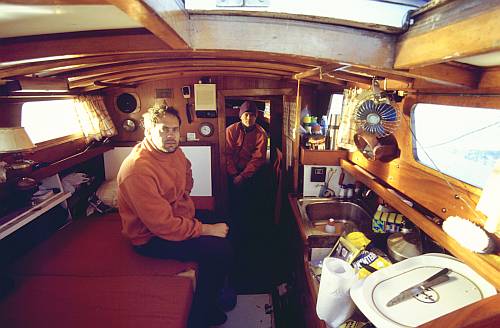 After spending
most of the night working, morning caught us much too early. But it was
a beautiful, sunny morning, with completely cloudless sky. Don't forget
that this was in mid winter, in a zone where it rains so much that people
have to turn the rain into song! So we set sail and aimed south, towards
the Comau fjord.
After spending
most of the night working, morning caught us much too early. But it was
a beautiful, sunny morning, with completely cloudless sky. Don't forget
that this was in mid winter, in a zone where it rains so much that people
have to turn the rain into song! So we set sail and aimed south, towards
the Comau fjord.
You can see here that the Capt'n's bunk is also the dinner table. It
only has to be installed a bit higher. Oh yes, and the dinner table is
also the navigation table. Often these two uses conflict. In contrast,
the Capt'n's sleeping doesn't conflict with either dinner or navigation:
If the table is needed, the Capt'n is simply thrown out of his bunk!
Oh, I almost forgot: The Capt'n's bunk, the dinner table, and the navigation
table are also the workshop bench. Did I talk about conflicts? Well, this
is how things go in a small yacht! The bow cabin, where Michael and
I slept, is also the sail stowage room, holds the freshwater tanks, some
life vests, and much of the food supply. The kitchen sink doubles as bathroom
sink. It's the only place where you can draw freshwater. And now, please
don't ask me whether the bottled drinking water supply and the loo share
the same location. I won't answer that question!
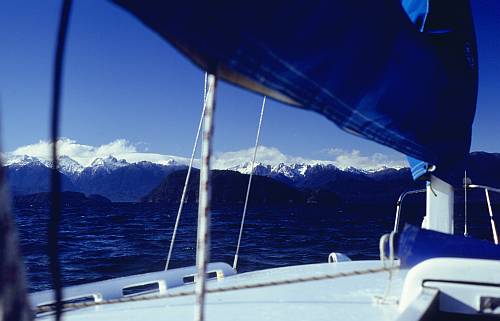 Our sailing that
day didn't last very long. In near gale wind, the jib went overboard
when the rotten halyard decided to give way. The Capt'n had thoughtfully
installed a backup halyard, so we fished the sail out of the water and hauled
it up again. But after a while, the sail again went overboard, this time
because the top block failed! Now there wasn't much to do, we could no
longer use the jib. Climbing the mast while the sloop rolls is not a very
good idea. And without a jib, only under main sail, this boat does
not behave very well. So we took the main sail down too, and continued
the day's trip under engine power.
Our sailing that
day didn't last very long. In near gale wind, the jib went overboard
when the rotten halyard decided to give way. The Capt'n had thoughtfully
installed a backup halyard, so we fished the sail out of the water and hauled
it up again. But after a while, the sail again went overboard, this time
because the top block failed! Now there wasn't much to do, we could no
longer use the jib. Climbing the mast while the sloop rolls is not a very
good idea. And without a jib, only under main sail, this boat does
not behave very well. So we took the main sail down too, and continued
the day's trip under engine power.
The Volvo Penta in the Capricornio is intended only as an auxiliary engine,
not as the main source of propulsion. The sloop is slow under sail, and
it is very slow when using just the engine! Every little fishing
boat seemed to go three times as fast as we did, and that's not an exaggeration
considering that we were doing just over four knots of speed! Even so,
Michael calculated that we would reach our destination for the day, the
narrow fjord of Cahuelmó, just before darkness. So we were in good
mood, relaxed, cooked a meal, fixed things, and above all, enjoyed the
landscape.
Southern Chile is one of the very few places in the world where you
can sail in a maze of channels, protected bays and more open waters, around
thousands of little and larger islands, most of them uninhabited and never
damaged by humans, always within sight of snowcapped mountains. The snow
in some places reaches right to the sea, and wherever there are no people,
the forest reaches the sea. There are few beaches; at most places the shores
are rocky and very steep. It's common to sail within an easy stone throw
of the shore, while the water is so deep that the depth finder is out of range!
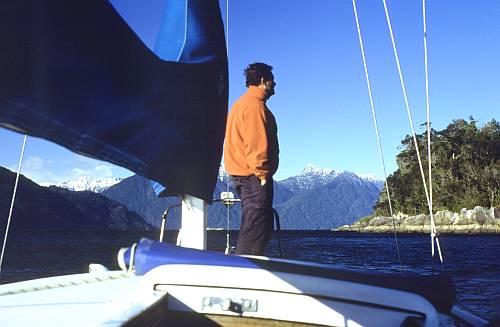 The Capt'n was
enjoying the view. The Capricornio had spent almost all of its previous
years in Antofagasta, a desert port, where the coast is invariably dry
and sterile. Traveling along dense jungle on his yacht was a welcome change.
The Capt'n was
enjoying the view. The Capricornio had spent almost all of its previous
years in Antofagasta, a desert port, where the coast is invariably dry
and sterile. Traveling along dense jungle on his yacht was a welcome change.
If my memory is right then the island on the right is Liliguapi, and
that on the left is Llancahué. We are on the Comau channel, going
to the Comau fjord in the background. The mountains straight ahead, all
the way to the coast, are part of the Pumalín park, a private nature
preservation area larger than many national parks, which has generated
much controversy because it is owned by a foreigner and extends all the
way from the sea to Chile's border with Argentina. Across the border, his
wife holds similar extensions of land. Even so, at the time of writing
this, 2005, it seems that most of the problems have been worked out, and
Pumalín appears on recent Chilean maps with the same status as a
national park.
If you ask me, my opinion is pragmatic: Any initiative to preserve
nature, in an area as beautiful, fragile and special as this, is most welcome,
no matter whether it's the government or a private person who does it,
and no matter whether the initiative comes from a Chilean or anyone else.
The alternative to preservation is typically a sparse settlement, clear-cutting
the forest, followed by dramatic soil degradation caused by erosion from
the wind and the very heavy rain. The waterways get choked by runoff, and
the area turns into a steppe with very little vegetation. Such damage has
been done to large areas of Chile, including some just 200km south from
here. Comparing the view of such a degraded place (see an example),
to a pristine one like our Capt'n is admiring here, brings dramatic clarity
to the need for preservation.
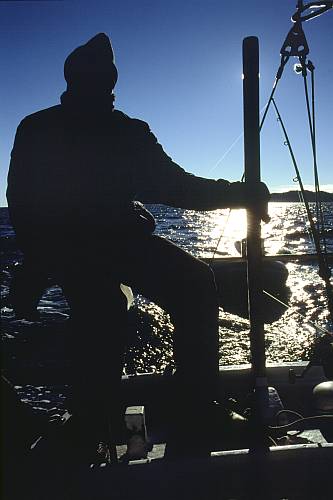 The Capt'n is
taking a turn at the helm. We still couldn't use the autopilot, because
the sloop's deck had been fiberglassed recently, and in
the process the connector for the autopilot had been removed! With so many
more important things to repair, we had not yet found the time to reinstall
it.
The Capt'n is
taking a turn at the helm. We still couldn't use the autopilot, because
the sloop's deck had been fiberglassed recently, and in
the process the connector for the autopilot had been removed! With so many
more important things to repair, we had not yet found the time to reinstall
it.
Most of the time I was at the helm, simply because that way I didn't
get seasick so easily. But when the water was very smooth, like this evening
approaching Cahuelmó, I could actually go below deck and fix things,
cook, clean my photo gear which always got salt water on it and didn't
like that treatment, and then use it to make some nice photos.
I hope some day scanners and computer screens will reach the quality
level required to reproduce the starkly beautiful look of images like this,
when projected from a slide, through a good lens, onto a large screen...
Until then, you will have to bear with these computer images in lousy resolution
and even more lousy contrast range, or come to Chile and attend one of
my slide shows!
Do you see the fishing rod? Well, Michael somehow had the crazy idea
that the sea would be full of fish, and that these fish would like to
bite his hook. But southern Chilean fish are clever, and when a shiny thing
hangs from a moving vessel, they know better than to bite it! We trailed
the fishing hook during our entire trip, and caught absolutely nothing!
The thing was a sea anchor, to keep us from overspeeding...
Michael tried every hook he had, with artificial lures of different sorts,
with baits consisting of kitchen residues, fresh shellfish gathered at
the anchorages, and a lot more things. Unfortunately we couldn't eat the
shellfish ourselves, because there was an infestation of Red Tide, which
accumulates in shellfish, does not harm them, but is so toxic to humans
that a single infected shellfish can kill the person who eats it! So we
kept trying them as bait. Only later did we realize that our Intrepid Boatswain
missed the most important of experiments: He should have taken a waterproof
pen and written a little sign: Dear Mister Fish, please bite on this
nice thing. You will be hooked, I promise! Yours truly, Michael.
Maybe
that would have worked better!
Having no fish to cook, that evening we dined on my special issue Greek
Salad, with gherkins, tomatoes, olives, goat cheese, extra virgin olive
oil, oregano, and some secret ingredients which I won't divulge here. The
glasses were filled with a nice red wine. It was accompanied by one beef
steak for me, three for the Intrepid Boatswain, and eight for the Capt'n.
After all, he deserved them because he had actually worked this day, taking
a turn at the helm for all of fifteen minutes!
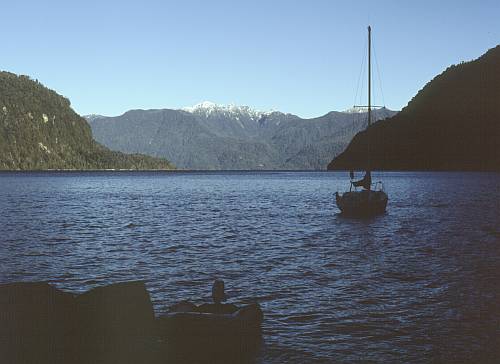 We anchored
as far inside in the Cahuelmó fjord as we could get. The bay continues
to the left from here, but with shallow waters that at the lowest tide
are too shallow for the Capricornio.
We anchored
as far inside in the Cahuelmó fjord as we could get. The bay continues
to the left from here, but with shallow waters that at the lowest tide
are too shallow for the Capricornio.
Anchoring in these waters is not as easy as throwing the anchor and
relying on it! The sea floor goes down at an angle steeper than 45
degrees, just like the mountains go up! So the anchor will slide down,
pull the us away from shore, until it hangs free from its chain and the
boat drifts off! Instead, the anchoring process here
consists of getting close to shore, setting out the dinghy, letting the
Intrepid Boatswain climb the shore, and tie a line to a sturdy tree or a
rock. Then the boat is moved until the depth finder reads a convenient depth,
maybe 15 meters. Only that often it doesn't read anything, because
the bottom is so steep that it doesn't get any reflections! Then,
an old fashioned piece of rope with a weight at the end and marks along
its length has to be used
to sound the depth. When deciding which depth is good, one has to keep
in mind the tides, because they are pretty extreme here, sometimes reaching
up to eight meters! Anyway, at the proper location the line is made fast to
the stern, and the bow anchor is lowered. The anchor slides down and pulls
the chain and rope tight, while the boat ends up in a fixed position,
looking straight away from shore, ready to sprint if anything requires
this action!
I shot this photo in the early morning - our third day at sea, and the
second completely cloudless one, in mid winter in one of the rainiest places
in the world!
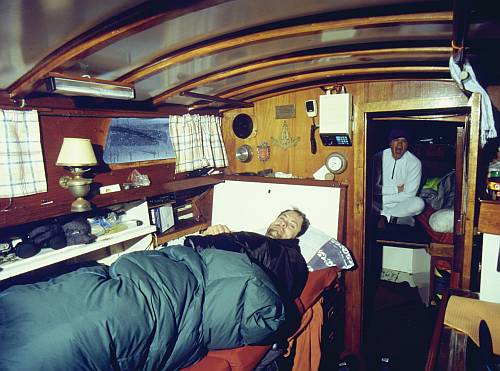 When I returned
from my early morning photo trip, the rest of the crew was just thinking
about the remote possibility of trying to wake up. Look closely at the
face of the Intrepid Boatswain in the background, and you will get the picture!
When I returned
from my early morning photo trip, the rest of the crew was just thinking
about the remote possibility of trying to wake up. Look closely at the
face of the Intrepid Boatswain in the background, and you will get the picture!
It always took quite a bit of self-control to get up. During the day,
the temperature was one or two degrees above freezing, but in nighttime,
it was well below. Whenever we had the engine running, and up to two hours
after, we had some heating from it, but in the early morning it was definitely
cold. Getting out of the nice warm sleeping bags, into the cruel, solid-frozen
world, was never easy!
It's interesting to note how we internalized the low temperature. The
second evening, while I was clearing up the mess in the galley/washing room/Capt'n's
cabin/navigation room/workshop/radio room, I kept tripping over the half
cow (one quarter of the original three quarters had already been consumed).
So I handed the parcels of meat to the Capt'n, who was standing on deck
staring into the sky (he says that's his duty too, as it is necessary for
forecasting the weather). I said: "Put this in the freezer, please", and
he placed it on deck, in a spot protected from spray, without even thinking
twice about the freezer thing! It was too plain obvious that the entire
deck could be used as a big freezer!
But they finally did get up, and there was work to do, specially for
The Intrepid Boatswain!
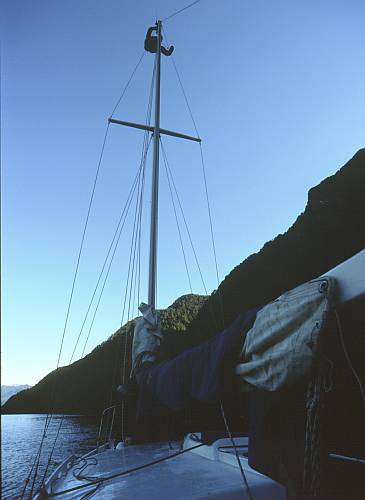 The only way
to fix the problem with the jib was climbing the mast and installing
a new top block. That's definitely not a task for the faint of heart,
and a certain degree of bodily fitness isn't unwelcome either. The day
and location was perfect for it, with absolutely still water, so that the
Capricornio didn't move, unless we did.
The only way
to fix the problem with the jib was climbing the mast and installing
a new top block. That's definitely not a task for the faint of heart,
and a certain degree of bodily fitness isn't unwelcome either. The day
and location was perfect for it, with absolutely still water, so that the
Capricornio didn't move, unless we did.
Michael improvised a climbing harness, which was tied to the main sail halyard.
Then he climbed up, with us other two helping
at the sail winch. In some countries they make contests of "climbing the
greased pole". Well, this pole wasn't greased, but it was rather slippery
anyway, thanks to many layers of oil paint on the Oregon Spruce. With some
help from the halyard, he was up at the mast top in a matter of a minute.
There he secured his harness to an additional hook, and freed up his hands
to work.
So, now at least you know why we call our Boatswain "intrepid"!
The installation of the new block and halyard went quickly. But he also
took time to check the VHF antenna connection. This antenna, despite being
mounted at the mast top a good 13 meters above sea level, was providing
very poor performance. Michael isn't a radio man - that job is mine - but
it was obvious enough for him that the antenna needed service, as it was
heavily corroded. But we had no means on board to try that, and since the
antenna still worked well enough to have radio contact with passing vessels
and coastal stations within sight, he left it at that.
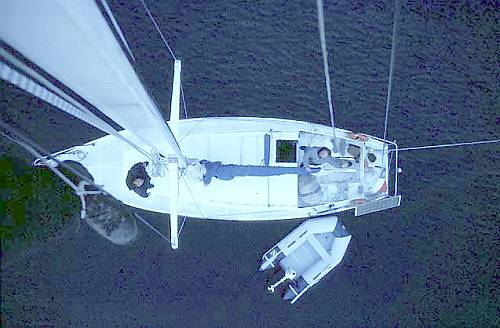 When Michael
was ready with the hard work, he devoted some time to tourism, and asked
us to send up his camera. We had an auxiliary line in place to move up
and down all the tools and materials he needed to fix the sail problem,
and so his entire camera bag went up the mast. Thanks to this, now you
know not only why we consider him intrepid, but also now you know how a
sloop looks from 13 meters up on the mast! It looks pretty small,
don't you think?
When Michael
was ready with the hard work, he devoted some time to tourism, and asked
us to send up his camera. We had an auxiliary line in place to move up
and down all the tools and materials he needed to fix the sail problem,
and so his entire camera bag went up the mast. Thanks to this, now you
know not only why we consider him intrepid, but also now you know how a
sloop looks from 13 meters up on the mast! It looks pretty small,
don't you think?
Thanks, Michael, for this photo!
Actually, before climbing the mast of such a boat it's a good idea
to do the math. It's easy: The sloop has a known weight at a known depth
under its center of gravity, defined mostly by the lead weight carried
in the keel. It's about 1400kg, 1.4m under water. A typical Intrepid Boatswain
will weigh about 75kg and his center of gravity will be about 12m
above the waterline. That works out well enough. But if we also sent up
the belly-fitted Capt'n to help Michael, and specially if that is done
after the Capt'n has eaten eight beef steaks, the poor Capricornio would
feel very inclined to take serious measures against such abuse, and would
dunk both of them into the chilly water through its inclination! :-)
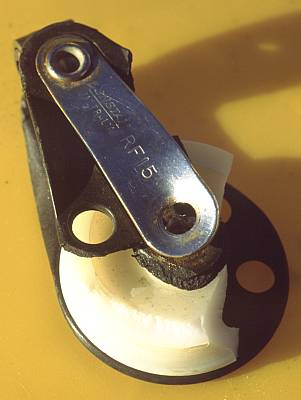 This was the
culprit for Michael's skyward trip. It looks like the plastic wheel became
brittle, probably due to UV exposure, and broke, which made the halyard squeeze
itself into the little room between the broken wheel and the sides, thus
bursting the riveted axle and coming down.
This was the
culprit for Michael's skyward trip. It looks like the plastic wheel became
brittle, probably due to UV exposure, and broke, which made the halyard squeeze
itself into the little room between the broken wheel and the sides, thus
bursting the riveted axle and coming down.
It's always a riddle what materials to use on a sailing boat. Each
material has its own set of disadvantages. Plastic is impervious to rusting,
but degrades with sunlight. Metal is impervious to sunlight, but it rusts
- and that's true even for so-called stainless steel! The rusting is much
slower, true, but specially in the presence of abrasion, stainless steel
does corrode. And it's not as simple as saying "stainless steel", and "plastic"!
There are countless variations of each, each with its own strengths and
problems.
Now, if abrasion is a problem, bronze can be quite good. But don't take
the much more common brass for bronze! Many people think they are the same
stuff, only because their colors are quite similar. And of course, don't
put two different metals in electric contact with each other. If you do,
the metal that's higher on the electrochemical scale will be just fine,
and totally eat up the other one! That process works surprisingly fast
when there is salt water around. In this regard, plastic shines. But when
the sun shines, plastic stops to shine... specially when it is white and
even worse when it is transparent.
All the above is just to convince you that our dear, infallible Capt'n,
deserves to be excused for having installed the wrong kind of block atop
his mast!
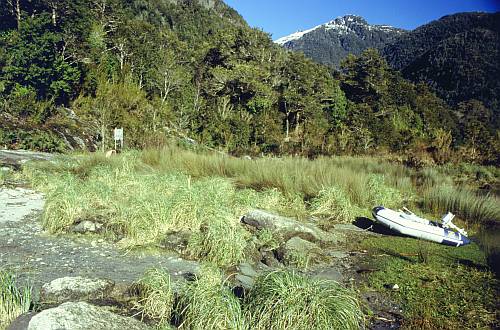 For the rest of
the day, we went to the thermal baths of Cahuelmó. They are located
at the end of the fjord, accessible only in a small boat during high tide.
The Capt'n told the Intrepid Boatswain to check the amount of fuel in the
dinghy's outboard engine. Michael had a look, said "more than enough",
and off we went, outfitted with towels, photo gear and a light picnic.
For the rest of
the day, we went to the thermal baths of Cahuelmó. They are located
at the end of the fjord, accessible only in a small boat during high tide.
The Capt'n told the Intrepid Boatswain to check the amount of fuel in the
dinghy's outboard engine. Michael had a look, said "more than enough",
and off we went, outfitted with towels, photo gear and a light picnic.
When we had done about half the way, suddenly the engine sputtered,
then stopped. The fuel tank was dry! Mr. Boatswain muttered something in
the line of "never thought this damn thing burns that much fuel", but that
insight didn't help now. You have permission to guess who had to row us
the rest of the trip!
Once ashore, we found this nice place, with some rustic installations,
consisting mostly of bathtubs dug in the soft rock, a simple open shelter
for rainy days, and a sign that welcomes visitors, invites them to enjoy
the place, and asks them to avoid any damage and to take any trash back
with them. This thermal bath, along with everything you can see on this
picture except the boat, is part of the Pumalín park.
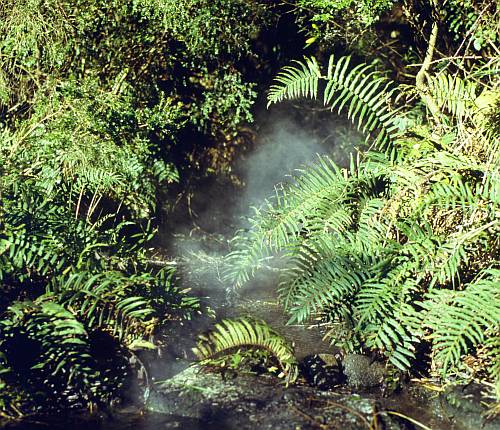 This is the main
hot spring. A nice creek of boiling hot water comes out of the ground,
between ferns and other plants adapted to the higher temperature around
the hot water. Even in the water proper there is life, with algae and bacteria
adapted to the very high temperature. The water is much too hot to put
your hand in at this place! The remains of insects litter the creek. These
are simply not programmed by nature to understand that water can be unhealthily
hot, and so they sometimes get too close, or fall in. Eventually Darwin
will work his ways here, and natural selection will produce a population
of insects who know how to respect hot water. But obviously, the process
is still under way.
This is the main
hot spring. A nice creek of boiling hot water comes out of the ground,
between ferns and other plants adapted to the higher temperature around
the hot water. Even in the water proper there is life, with algae and bacteria
adapted to the very high temperature. The water is much too hot to put
your hand in at this place! The remains of insects litter the creek. These
are simply not programmed by nature to understand that water can be unhealthily
hot, and so they sometimes get too close, or fall in. Eventually Darwin
will work his ways here, and natural selection will produce a population
of insects who know how to respect hot water. But obviously, the process
is still under way.
The water runs off through channels that allow it too cool off until
it has reached a temperature that no longer burns bathers. One can build
little dams in some places, and open others, to choose how much distance
the water moves, and how much it cools, until reaching the first pools.
Our hydraulic engineer Michael, the very same guy who build the Capricornio's
pumping plumbing and left us stranded without fuel, was in his element
here, and brought the water to perfect temperature.
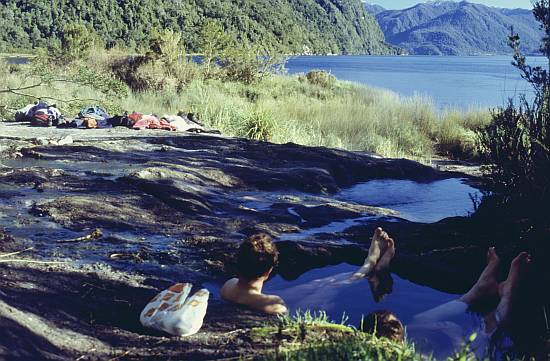 Ha, that's life!
Resting in the warm water, under blue sky, surrounded by some of the world's
most pristine nature, away from the haste, noise and stink of cities, nibbling
on assorted nuts and fruit!
Ha, that's life!
Resting in the warm water, under blue sky, surrounded by some of the world's
most pristine nature, away from the haste, noise and stink of cities, nibbling
on assorted nuts and fruit!
We were a little worried about the low tide starting soon. When that
happens, the currents become a bit strong for the dinghy, very specially
when the engine has no fuel left... And a while later, there is no water
left, only mud, densely populated by shellfish with sharp edges. And if
there's one thing an inflatable boat doesn't like, it's being dragged over
sharp shellfish! But the water was so relaxing that the Capt'n stretched
his tide calculations as far as he could, and we enjoyed the place royally.
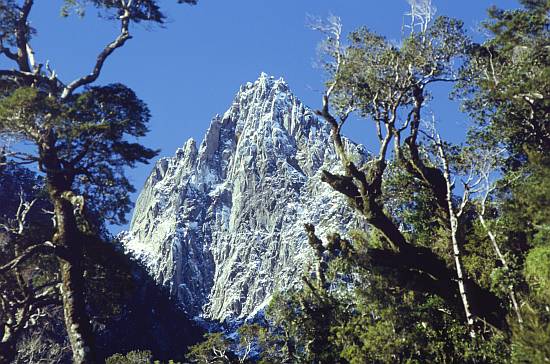 This
is the view to the other side, from the thermal pool. We just had to turn
our heads to look at this. Michael is also an avid mountain climber, and
can be a bit hard to hold back. He almost ran away and up this mountain!
And to speak the truth, I was really tempted to accompany him on that noble
endeavor, if it were not for my stupid arthritic hip that has kept me mostly
away from long walks and climbs in recent years.
This
is the view to the other side, from the thermal pool. We just had to turn
our heads to look at this. Michael is also an avid mountain climber, and
can be a bit hard to hold back. He almost ran away and up this mountain!
And to speak the truth, I was really tempted to accompany him on that noble
endeavor, if it were not for my stupid arthritic hip that has kept me mostly
away from long walks and climbs in recent years.
This picture was shot through a selected Pentax 200mm f/2.8 extra low
dispersion lens, used at its optimal aperture. The original slide shows
an amount of detail so impressive that one thinks each snow crystal registered
separately on the film! Of course, the 500-pixel-wide scan cannot start
to do justice to this, so, please imagine how the slide looks! :-)
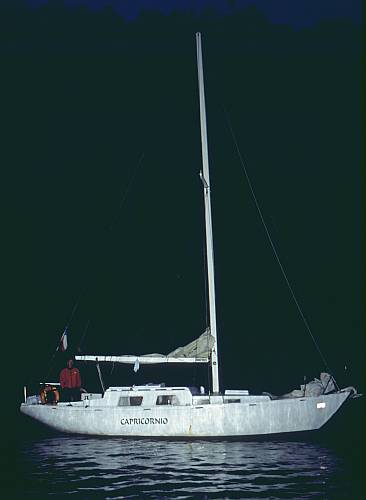 At 15
hours the sun set behind the tall mountains, and we returned to the Capricornio.
We scratched the mud in many places, had to turn around a few times, and
then the Capt'n had to help rowing to get us across the current caused
by the river which empties into this bay, or we would have drifted past
the yacht and out onto the sea.
At 15
hours the sun set behind the tall mountains, and we returned to the Capricornio.
We scratched the mud in many places, had to turn around a few times, and
then the Capt'n had to help rowing to get us across the current caused
by the river which empties into this bay, or we would have drifted past
the yacht and out onto the sea.
Night falls by about 17:30 in this time of the year, so the evenings
were long. Several times we went ashore in darkness, and at other times
we played around with the dinghy, properly refueled, shooting pictures.
This one was taken with flash lighting. The distance necessary to get the
whole sloop onto a photo was much larger than what the flash is rated to
cover, but with a shiny white yacht, that's no problem! Michael was surprised
when he first saw this photo. He thought it would turn out black, like
all those countless photos shot by silly people with little automatic cameras,
trying to use the internal flash to light a landscape many kilometers away!
Well, like many people these days, he didn't consider the abilities of
an f/1.4 lens combined with the high reflectivity of the white paint!
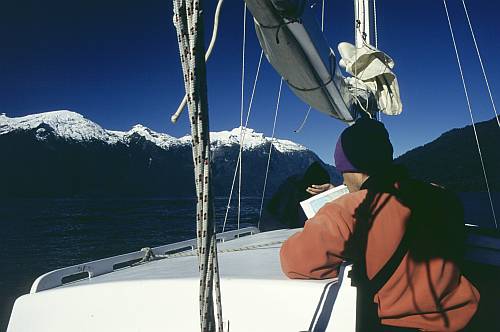 The next day
we left Cahuelmó and continued south along the Comau fjord, in an
incredible weather. This was the third cloudless day in a row! If
it hadn't been for the low temperature and the snow on even the smaller
mountains, it would have been hard to believe that this was mid winter!
The next day
we left Cahuelmó and continued south along the Comau fjord, in an
incredible weather. This was the third cloudless day in a row! If
it hadn't been for the low temperature and the snow on even the smaller
mountains, it would have been hard to believe that this was mid winter!
Since the hot baths of Cahuelmó had been so enjoyable, we wanted
to try more such places. Everyone in the area recommended the thermal springs
of Porcelana. But every person we asked gave us different directions! So
we took down the sails, and motored very slowly along the suspect coast,
trying to detect any clues to where it could be. Michael tried to
extract all possible clues from the maps, which listed a Porcelana river,
a Porcelana bay, a Porcelana village, a Porcelana farm, a Porcelana point,
a Porcelana salmon hatchery, all at different places, but no Porcelana
thermal baths at all!
We ended up anchoring in a little bay and going ashore in the dingy,
at a beach that looked like it had some human traffic. There was a little
trail, and after five minutes walking we reached a little ranch house.
Michael called loud, because when in this very sparsely populated area
visitors arrive unexpectedly, it's not unheard of that the houseowner reacts
in panic and uses his shotgun! But that's rare, fortunately. In such places
most all people are good, and welcome visitors.
The owner of the little ranch turned out to be a friendly man, who came
out of his house to welcome us. He lived there, in the middle of paradise,
with his wife and children, raising cattle and planting some subsistence
crops. He had built quite a nice little world, with a water turbine in
a stream that provided him electricity. He had a refrigerator, a TV, even
a marine radio that served as emergency link to the "civilized world".
When I see people living like this, I can't help the impression
that they are hugely more civilized than we city dwellers are.
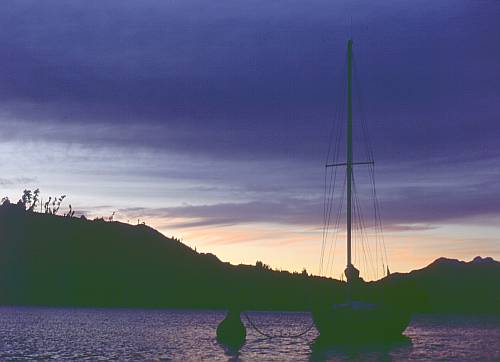 The rancher told
us exactly where the thermal springs were located. But the anchorages near
that place were openly exposed to the wind and waves at that moment, and
since it was getting late and the wind kept increasing, we decided to sail
all the way to Leptepu, the last corner of the Comau fjord. There
we reached a very well protected little bay, with two large anchored buoys
floating near a shuttle ramp. This was a port built for Ro-Ro ships that
were supposed to land cars and trucks for a very short stretch of Chile's
Southern Road, but later this was found uneconomical and now this stretch
of road is skipped and the Ro-Ros bring the vehicles directly to the next
port. So we took possession of one of the buoys, and made fast to
it.
The rancher told
us exactly where the thermal springs were located. But the anchorages near
that place were openly exposed to the wind and waves at that moment, and
since it was getting late and the wind kept increasing, we decided to sail
all the way to Leptepu, the last corner of the Comau fjord. There
we reached a very well protected little bay, with two large anchored buoys
floating near a shuttle ramp. This was a port built for Ro-Ro ships that
were supposed to land cars and trucks for a very short stretch of Chile's
Southern Road, but later this was found uneconomical and now this stretch
of road is skipped and the Ro-Ros bring the vehicles directly to the next
port. So we took possession of one of the buoys, and made fast to
it.
This photo was shot with a half-second exposure time from the dinghy!
Take that! The water was so incredibly calm that I could pull off this
trick.
This was the best night of all. No fear of dragging the anchor, absolute
protection from any storm that could come up, a beautiful landscape, still
being mostly clean from bathing at Cahuelmó, and the promise of
the next warm bath in Porcelana. On top of this, the Capricornio was improving
steadily, with all the minor and major fixes we were doing. When we set
out from Puerto Montt, none of the navigation lights were working. Along
the trip I fixed wiring, fuse boxes, distribution cabling, and so on, and
at this time we had all the lights we needed. We had also finally reinstalled
the connection for the autopilot. The speed log wasn't working, but that's
a minor thing because we had a GPS receiver which could supply speed data.
The sails were all fine, the engine too, even the generator was still working,
the solar panel had gotten lots of sun. The main problems were in the radio
area: The VHF radio really didn't reach far with the corroded antenna,
and the Capt'n was missing some music! The Capricornio used to have a car
radio, but that one went away into a better life shortly before the deck
was fiberglassed, because there were leaks and one of these was just above
the radio!
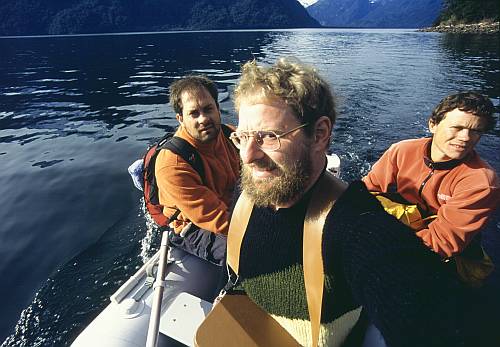 The next day
we went to the Porcelana thermal baths in the dinghy. I can assure you,
this time our Intrepid Boatswain filled up the outboard engine's tank to
the brim, and then he left the fuel canister in the boat, just to be sure!
The next day
we went to the Porcelana thermal baths in the dinghy. I can assure you,
this time our Intrepid Boatswain filled up the outboard engine's tank to
the brim, and then he left the fuel canister in the boat, just to be sure!
In an inflatable boat that is barely the size of a bathtub, and
loaded with three people, it's not easy to make a group photo that includes
the photographer. But it can be done, with a long and very extended arm!
:-)
This morning it was slightly cloudy, but still there were no signs of
rain. And the sun was coming through from time to time.
We left the boat where the Porcelana river met the Porcelana bay, and
walked along the river, first along pastures, soon into the forest.
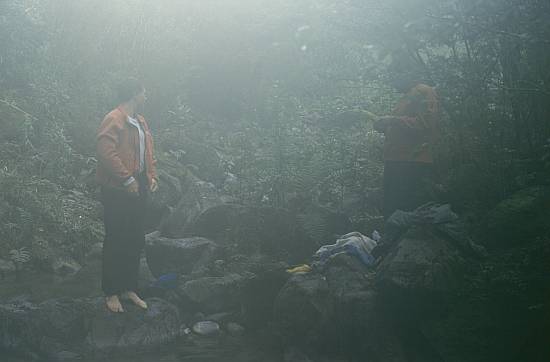 Soon we found steam
wafting through the air. That was a good sign! We followed the thickest
steam, and soon enough the water that trickled along the mostly dry riverbed,
which runs at a few meters distance from the main, very wet and very cold
river, became warm enough to walk barefoot in it.
Soon we found steam
wafting through the air. That was a good sign! We followed the thickest
steam, and soon enough the water that trickled along the mostly dry riverbed,
which runs at a few meters distance from the main, very wet and very cold
river, became warm enough to walk barefoot in it.
We continued slightly uphill, trying to find out where the warm water
came from, and found many small dispersed springs. The higher we got, the
more springs we found, and the warmer they were.
We had been told that after intense rains, the thermal springs were
flooded by the river. But now it hadn't rained for several days, the river
was low, and the springs were well exposed.
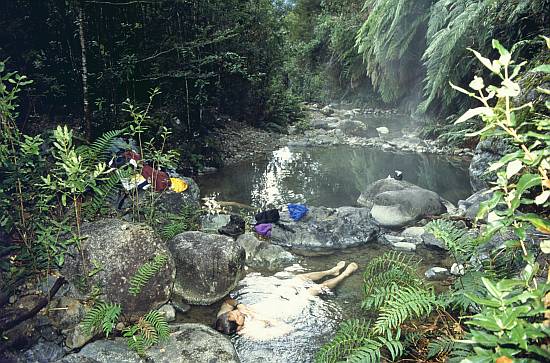 Finally we found
this to be the ideal spot for bathing. These pools had a good temperature.
Not nearly as boiling hot as the water from Cahuelmó, but warm enough
to be very comfortable. We spent some hours in the water, until we were
all shriveled up.
Finally we found
this to be the ideal spot for bathing. These pools had a good temperature.
Not nearly as boiling hot as the water from Cahuelmó, but warm enough
to be very comfortable. We spent some hours in the water, until we were
all shriveled up.
Take a look at these ferns! Many of them exceed two meters in length.
The rest of the vegetation is equally lush. It seems that the slightly
higher temperature and guaranteed humidity ensured by the warm spring helps
the plants grow especially beautiful.
After getting thoroughly wet, warm, clean and shriveled, we got dressed
and returned to the Capricornio. The day had still enough daylight hours left
for us to start our northward return, so we decided to set out for Cahuelmó
again and spend the night there.
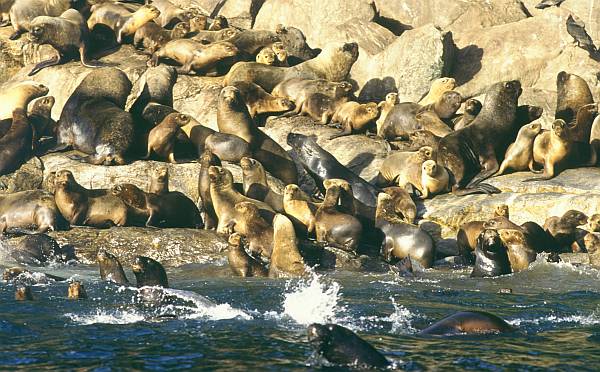 At the entry to
the Cahuelmó fjord there is a large colony of sea lions. All the other
times we passed by that point, the animals were away fishing - I trust
they had more luck than we did -, but this time we found them at home,
playing, roughhousing, taking plunges, and singing their song in all kinds
of voices from the sopranos of the little ones to the ultra deep, somewhat
raspy bass of the big old males.
At the entry to
the Cahuelmó fjord there is a large colony of sea lions. All the other
times we passed by that point, the animals were away fishing - I trust
they had more luck than we did -, but this time we found them at home,
playing, roughhousing, taking plunges, and singing their song in all kinds
of voices from the sopranos of the little ones to the ultra deep, somewhat
raspy bass of the big old males.
When we got here, turning from the Comau fjord into Cahuelmó,
we got out of the wind. There was just the slightest imaginable trace
of any air motion. We left the engine off, and the Capt'n showed off his
truly good abilities in sailing a sloop in less wind than what we could
have blown ourselves. We sailed past the extensive sea lion colony, very,
very slowly, in complete silence except for the clicking of my camera,
at a distance so short from the rocks that I was a bit queasy about what
would happen if suddenly any significant wind turned up. But the
Capt'n was sure of his action, and the near pass gave me all the opportunity
I ever dreamed, to shoot sea lion photos!
The animals were not particularly upset by our presence. Some watched
us, others had more interesting matters to care about. When someone of
us had the bad idea to talk, however, that caused a general stampede into
the water! The older animals launched gracefully, belly-sliding down the
polished rocks and gliding elegantly into the water. The young ones instead
hadn't learned such elegance yet, and some of them tried to reach the water
from some higher lying rock, landing flat on their bellies on the next
rock below! It didn't seem to harm them the slightest bit. They joined
the others in the water, and then the whole colony decided that we were
not really dangerous after all, even if we talked, and they climbed their
rocks again.
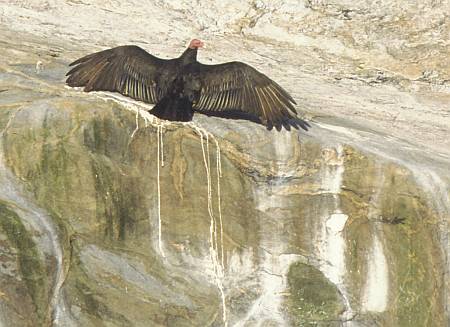 The only one
who got slightly disgusted by the whole show was this vulture, accustomed
to eating the remains of fish, after the sea lions are satiated. The birds
use to sit on the tops of the rocks, waiting for something edible to be
discarded by the mammals. But this guy got all soaked when the sea lions
went into the water en masse and splashed like little kids, and now he
has to dry off his plumage in the late afternoon sun! His angry look towards
us tells the whole story!
The only one
who got slightly disgusted by the whole show was this vulture, accustomed
to eating the remains of fish, after the sea lions are satiated. The birds
use to sit on the tops of the rocks, waiting for something edible to be
discarded by the mammals. But this guy got all soaked when the sea lions
went into the water en masse and splashed like little kids, and now he
has to dry off his plumage in the late afternoon sun! His angry look towards
us tells the whole story!
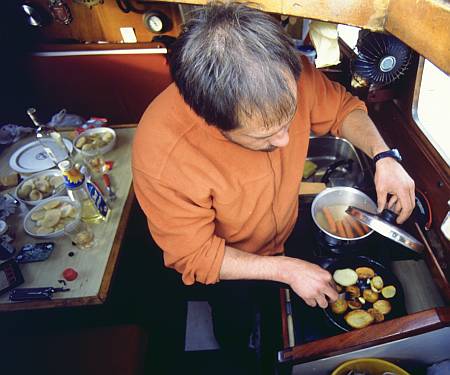 We kept sailing
into Cahuelmó, with next to no wind, while the Capt'n served his
kitchen duty by preparing some junk food. At the end, we had no choice
but to fire up the Volvo Penta again, because this sort of wind
would have taken far into the night to bring us to our planned anchorage!
We kept sailing
into Cahuelmó, with next to no wind, while the Capt'n served his
kitchen duty by preparing some junk food. At the end, we had no choice
but to fire up the Volvo Penta again, because this sort of wind
would have taken far into the night to bring us to our planned anchorage!
Such low wind in mid winter is always a bit suspicious. We tried to
get a weather forecast on the radio, but didn't get contact to anyone.
Anyway, we did make eyeball contact with a few fishermen who strayed into
the bay, and they told us that there was a forecast of possible foul weather
in the evening of the following day, so they advised us to leave Cahuelmó
in the morning. They said that with really foul weather, it can be impossible
to get out of the bay, and that the place where we were anchoring could
turn bad too. But they also told us to enjoy a good night's sleep, because
there was no risk for the night.
We watched the barometer that evening, and it was dropping more than
usual. So we decided to set out early the next day, trying to get as far
as possible before the expected foul weather came in. After all, we had
return air tickets with fixed dates on them, and didn't want to loose them
by sitting out a storm for three days!
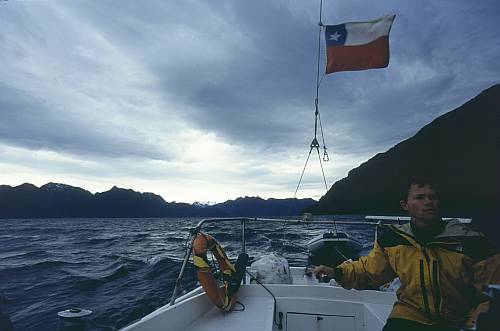 Our escape started
very nicely. We had strong south wind, which usually is an indication of
good weather. It was the ideal wind direction, and the good old Capricornio
felt a bit like a racing sloop! The barometer had stabilized, and so, despite
the cloudy weather, we were not overly worried.
Our escape started
very nicely. We had strong south wind, which usually is an indication of
good weather. It was the ideal wind direction, and the good old Capricornio
felt a bit like a racing sloop! The barometer had stabilized, and so, despite
the cloudy weather, we were not overly worried.
As we left the Comau fjord and came into more open waters, the sea got
so rough that our newly reinstalled autopilot could not keep the sloop on
course. The heavy waves from aft threw us off course, and much before
the autopilot's servo had locked to the right course again, the next wave came. So,
we were back to manual control, a task our Intrepid Boatswain enjoyed profoundly.
The dinghy, trailed by way of an elastic cord, was gliding on the water,
from one crest to the next, and we joked that it was about time that the
Capt'n purchased some water skis for times like this!
Do you know how you save freshwater and fill the kitchen sink, effortlessly,
with salt water? Well, you tell the helmsman to take the wind hard from
port. The boat heels over heavily, and if the sink plug is open,
water rushes in automatically through the drain line. When you have enough,
you put in the plug and tell the helmsman to return to the normal course,
the sloop rightens itself, and you can wash the dishes! It works like a
charm in wind like this!
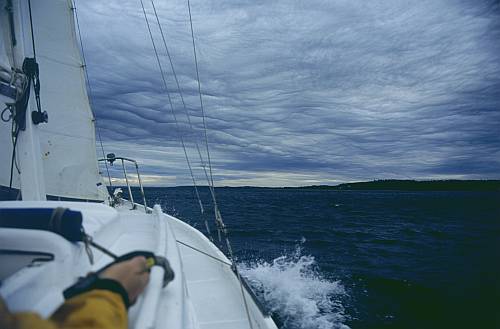 After lunch time,
we came into an area with very strange-looking sky. The very shape of the
cloud protuberances told us that there were layers of strong winds in different
directions. The Boatswain measured the wind, trying to get any clues at
what would happen, and when. The wind wasn't very strong now, and the sloop
was going fine under full sail. Even so, the Capt'n decided to reef the
main sail a bit, to be better prepared for eventual gusts.
After lunch time,
we came into an area with very strange-looking sky. The very shape of the
cloud protuberances told us that there were layers of strong winds in different
directions. The Boatswain measured the wind, trying to get any clues at
what would happen, and when. The wind wasn't very strong now, and the sloop
was going fine under full sail. Even so, the Capt'n decided to reef the
main sail a bit, to be better prepared for eventual gusts.
We kept constant watch on the radio, trying to get some newer weather
forecast. But the sea seemed devoid of humans, within the reach of our
impaired radio. We did cross paths with one little fishing boat. The man
on board screamed something in our direction, but we couldn't understand.
We screamed back, asking what it was, he screamed again and continued his
trip, waving widely. Our interpretations ranged all the way from "Hello
guys, enjoy your trip!" to "Get the hell out of here,
before it's too late!" We called him on the radio, but got no
answer, which was expected because most of these fishermen have no radios
on their little open boats. So we had to decide what to do. Considering
that Rolecha was within not much more than one hour sailing at this speed,
and that alternative anchorages were plagued by shallow waters at their
inlets, the Capt'n decided to make the run for Rolecha.
And a while later the storm hit us. It came so violently and suddenly,
that it left us no time to react. A tremendously powerful gust pushed the
Capricornio on its side, causing a terrible mess under deck. Pointing into
the wind, we soon were upright again, but before we could take down the
sails, the main sail ripped and waved like old underpants held between
two fingers. With the main sail gone and the jib still up, the rudder
proved insufficient to keep control, and the wind hit us form the side
again. Only then we managed to free the jib, but that turned us into a
plaything of the storm and the waves. We fired up the engine and pointed
into the storm again. I had to exert real force on the helm, with wide
excursions to keep the vessel into the wind, while the Capt'n took down
the jib and the shreds of the main sail. Then things calmed down a bit,
but we realized that the waves were building up fast, and that the Volvo
Penta could barely push us against this wind!
A while later, the GPS showed us to be stationary, despite the engine
running at maximum emergency power. So, the Capt'n decided, for the first
time in the Capricornio's life, to set the tiny storm sail. There had never
been any need to use it, in the calm weather near Antofagasta! The storm
sail is a lot smaller than a wind surfer sail, and made of very thick fabric.
This sail gave us back some speed. The wind had turned north, so we had
to sail as close-hauled as possible. The engine was kept on full
emergency power, and together with the storm sail it gave us about two
knots of speed. The waves had build up enough that all the time water was
coming over deck. I need eyeglasses, and just couldn't keep them clear
enough to see, so I went down below, trying to overcome my tendency towards
seasickness, and babysitting the hard working engine while listening to
the VHF radio.
The Capt'n was proud of his brave yacht, and begged me to come up and
shoot some photos of the Capricornio under storm sail! But there was no
way to shoot photos out there, except with a submarine camera, which I
didn't have... So I stayed down below. I noticed that the bilge pump was
running almost nonstop. To my dismay I discovered that the hull was stressed
so much that sometimes the daylight, in addition to lots of water, squeezed
through between the individual planks! When I saw that, I took my
GPS, with spare batteries, the little handheld VHF radio, also with spare
batteries, packed it all in ziplock bags and stuffed it in my pockets.
After all, we still had the dinghy if the Capricornio broke up and went
down!
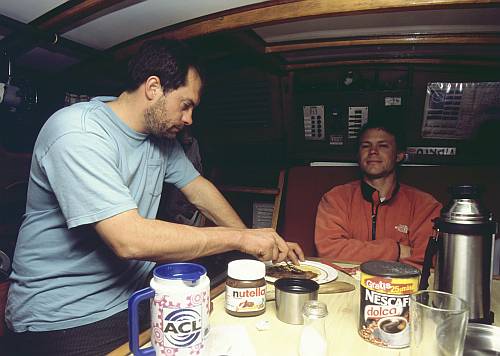 Too many hours
later, we managed to get into Rolecha bay. It provided decent protection
from the waves, but not from the wind. Still, it was the best place around,
as evidenced by scores of vessels of all sizes that had sought refuge here.
They welcomed us on the radio, and congratulated us for the bravery of
using a sail in this storm. Little did they know that it happened only
because our poor old Volvo Penta being too weak to handle such a situation
on its own!
Too many hours
later, we managed to get into Rolecha bay. It provided decent protection
from the waves, but not from the wind. Still, it was the best place around,
as evidenced by scores of vessels of all sizes that had sought refuge here.
They welcomed us on the radio, and congratulated us for the bravery of
using a sail in this storm. Little did they know that it happened only
because our poor old Volvo Penta being too weak to handle such a situation
on its own!
The problem was that the Rolecha bay has sandy bottom, and most of the
vessels were dragging their anchors. All the time someone would weigh
his anchor, motor a few hundred meters into the storm, then drop the anchor
again, only to be dragged back again. But our Capt'n was confident. He
said, quite modestly as is his trademark, that his anchor was the best
sand anchor in the world. We went to a place that was about 7 meters deep
(it was low tide) and seemed far enough away from other vessels, not an
easy task in this crowded place, and there the Capt'n dropped his sand
anchor, with 40 meters of nylon rode attached to its 30 meters of iron
chain, while I kept the vessel on spot with the engine. Then he took the
helm, cutting power and letting the storm push the boat back. WHAM! That
treatment made the anchor really bite into the bottom! It didn't
drag even one meter during the whole night!
Still, the worried face on this photo tells that we were not very comfortable.
Poor Capricornio shook like crazy. In the storm, the mast and shrouds entered
resonance, and the oscillations were so bad that we toyed with the idea
of stealing a chainsaw and cutting down the mast.
Amidst all this, we got hungry. We had been wanting to make pancakes
all along the trip, and now we had the perfect moment at hand to do it:
With the boat laboring so much, the pancakes flipped themselves! It was a simple
matter of waiting for them to jump high up into the air when a wave hit
the boat, and then catching them with the pan when they came down again!
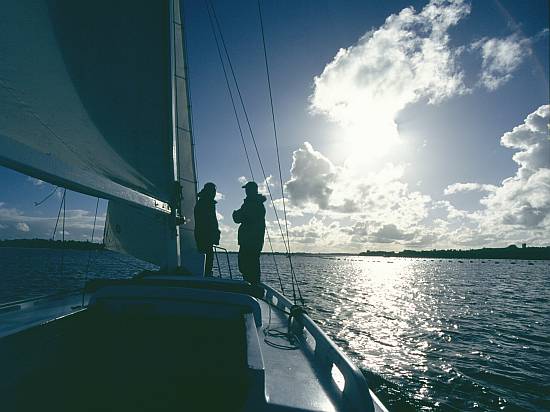 When the next
morning broke, the storm was ending. Even so, the port authority delayed
our leaving until 11:30, because the sea out there was still quite rowdy.
We used that time to fix the mainsail as best we could. It ended up
reefed to half its normal area, but usable.
When the next
morning broke, the storm was ending. Even so, the port authority delayed
our leaving until 11:30, because the sea out there was still quite rowdy.
We used that time to fix the mainsail as best we could. It ended up
reefed to half its normal area, but usable.
The weather was still unstable, so we decided to take the longer route
to Puerto Montt, in the sheltered channels between the islands of the Reloncaví
bay. That would have us sailing deep into the night. We had to reach Puerto
Montt that night, or Michael would loose his air ticket. The Capt'n's and
mine were for a few hours later, so for us it wasn't that critical.
The dynastarter was weak that morning, it actually had trouble getting
the diesel to run. Later we found out that it had been damaged by running
for several hours at top speed in the storm, with a regulator that didn't
really regulate. Most of the solder joints at the collector had unsoldered
themselves. Still, after the engine started, the dynastarter did work acceptably
as a generator, with low but sufficient output, so we didn't worry much.
We used the sails whenever there was enough wind, and filled the voids
with the engine. When the night fell, the wind stopped completely, and
we did the last five hours under engine power, with full lights, autopilot,
GPS-based navigation according to waypoints measured on the map and entered
manually, and it all went very well. The only anecdote happened when during
my turn as lookout, at one time I found us to be on a head-on collision
course with some other vessel of which I could see just the lights. Not
fluent in marine customs, and being a paraglider pilot who knows that things
are not always as obviously simple as in street traffic, I asked the Capt'n
to which side I had to evade the other vessel. His interesting answer:
"I don't know! Let me check the rule books!" And the lights were coming
closer, fast!
Well, a moment before the Capt'n had found the relevant page, the vessel
ahead turned a little to his right. Oh, now I know! So I turned a little
to my right too. When he came close enough to see him, it turned out to
be a large Ro-Ro. It would not have harmed him much to run right over the
little Capricornio!
In defense of the Capt'n, I feel obliged to add that the answer he came
up with was indeed the correct one!
Forward to another trip on the Capricornio
Back to the homo ludens nauticus index.
 Opening
my path into the bow cabin, I found another flashlight. It was heavy, which
meant that this one actually had batteries. Marvelous! But it didn't
work either... So, the problem could be the batteries, the bulb, or a contact.
I crawled back, found the other flashlight again, put the batteries of
the second one into the first, and Eureka, I had light!!!
Opening
my path into the bow cabin, I found another flashlight. It was heavy, which
meant that this one actually had batteries. Marvelous! But it didn't
work either... So, the problem could be the batteries, the bulb, or a contact.
I crawled back, found the other flashlight again, put the batteries of
the second one into the first, and Eureka, I had light!!!
 It was in mid winter
2004 when my friend and then workmate Germán invited me to sail
to the Comau fjord aboard his yacht Capricornio. You will understand that
at first I was a bit reluctant to go, considering that the summer before,
on the boat's and the Captain's first trip in the complicate waters of
Chiloé, more than one thing went wrong, with no electricity of any
sort on board, no radio contact, no lights, no bilge pump, the boat taking
on water like mad, the hand pump breaking down, the mast almost going overboard
when the forestay broke, and a few dozen other interesting happenings of
the kind that add spice to the seaman's life.. But then, errhm, I
thought that these nice fellows would not survive another trip without
my valuable help, and said yes!
It was in mid winter
2004 when my friend and then workmate Germán invited me to sail
to the Comau fjord aboard his yacht Capricornio. You will understand that
at first I was a bit reluctant to go, considering that the summer before,
on the boat's and the Captain's first trip in the complicate waters of
Chiloé, more than one thing went wrong, with no electricity of any
sort on board, no radio contact, no lights, no bilge pump, the boat taking
on water like mad, the hand pump breaking down, the mast almost going overboard
when the forestay broke, and a few dozen other interesting happenings of
the kind that add spice to the seaman's life.. But then, errhm, I
thought that these nice fellows would not survive another trip without
my valuable help, and said yes!
 It's
time for an introduction: This is the much bespoken Germán. From
now on we will respectfully call him "the Capt'n". Here he is showing his
impressive ability to give orders. The other main actor of this story,
Michael, will be often referred to as "The Intrepid Boatswain". You will
soon see why, so don't ask.
It's
time for an introduction: This is the much bespoken Germán. From
now on we will respectfully call him "the Capt'n". Here he is showing his
impressive ability to give orders. The other main actor of this story,
Michael, will be often referred to as "The Intrepid Boatswain". You will
soon see why, so don't ask.
 We threw all the
purchases into the sloop, set sail and sailed out on the Tenglo channel,
then straight south across the Reloncaví bay. This map, artfully
drafted by fellow sailor Alfonso Gonzales for this story, shows the area and
a rough sketch of our trip. Basically, we went south to the Comau fjord,
and then along all its length, visiting the beautiful places along it, and
taking refuge in sheltered bays during the nights.
We threw all the
purchases into the sloop, set sail and sailed out on the Tenglo channel,
then straight south across the Reloncaví bay. This map, artfully
drafted by fellow sailor Alfonso Gonzales for this story, shows the area and
a rough sketch of our trip. Basically, we went south to the Comau fjord,
and then along all its length, visiting the beautiful places along it, and
taking refuge in sheltered bays during the nights. It had stopped
raining, the sun had come through, the wind was perfect, and we enjoyed
it. Most of the time I would sit at the helm. The Capt'n loves to hang
out at the bow, so that's what he did most of the time. Michael, instead,
is the kind of guy who can't stay put for more than five minutes. He was
milling around, stowing away our supplies, cleaning up, cooking, fixing
things, reading the map, navigating, and so on. Sometimes I tried
to switch places with him - but I didn't last! I have an easily upset stomach,
and when the vessel rolls and pitches like it loves to do when the wind comes
from near the stern, like here, I must stay on deck and look at the horizon,
or I would soon feed the fish. And so, if I have to stay on deck anyway,
I might as well hold the helm...
It had stopped
raining, the sun had come through, the wind was perfect, and we enjoyed
it. Most of the time I would sit at the helm. The Capt'n loves to hang
out at the bow, so that's what he did most of the time. Michael, instead,
is the kind of guy who can't stay put for more than five minutes. He was
milling around, stowing away our supplies, cleaning up, cooking, fixing
things, reading the map, navigating, and so on. Sometimes I tried
to switch places with him - but I didn't last! I have an easily upset stomach,
and when the vessel rolls and pitches like it loves to do when the wind comes
from near the stern, like here, I must stay on deck and look at the horizon,
or I would soon feed the fish. And so, if I have to stay on deck anyway,
I might as well hold the helm...
 We sailed all
the way to Rolecha, a small village along a bay that offers good anchoring
ground and some protection. Soon the evening came, and on this photo you
can see how our first idyllic night on the Capricornio went: Working with
battery-powered headlamps to conserve the little remaining charge on the
main batteries, the whole crew is at work. The Boatswain was happily filing
away at a fitting he needed to complete an ultra-effective pump setup.
After the last trip, where he got duly fed up with hauling buckets, he
now wanted several pumps in good working order. The Capt'n is assisting
that noble effort, while I'm entirely devoted to the generator.
We sailed all
the way to Rolecha, a small village along a bay that offers good anchoring
ground and some protection. Soon the evening came, and on this photo you
can see how our first idyllic night on the Capricornio went: Working with
battery-powered headlamps to conserve the little remaining charge on the
main batteries, the whole crew is at work. The Boatswain was happily filing
away at a fitting he needed to complete an ultra-effective pump setup.
After the last trip, where he got duly fed up with hauling buckets, he
now wanted several pumps in good working order. The Capt'n is assisting
that noble effort, while I'm entirely devoted to the generator.
 When we started
the engine, the generator came to life, and delivered a huge current, much
larger than it should... Obviously the regulator, one of those old-style
electromechanical things, wasn't working very well. It did regulate, in
some way, but at a much too high level. So we regulated the generator output
via the engine throttle... We left the engine running for a good while,
watching with big smiles how the battery voltage climbed, and soon came
into the green range. This pretty much saved the trip! Actually the Capricornio
can sail without electricity, as it did in summer, but in winter that's
even more uncomfortable. Oil lamps of Aladdin's tradition give only so
much light, and don't power a VHF radio very well...
When we started
the engine, the generator came to life, and delivered a huge current, much
larger than it should... Obviously the regulator, one of those old-style
electromechanical things, wasn't working very well. It did regulate, in
some way, but at a much too high level. So we regulated the generator output
via the engine throttle... We left the engine running for a good while,
watching with big smiles how the battery voltage climbed, and soon came
into the green range. This pretty much saved the trip! Actually the Capricornio
can sail without electricity, as it did in summer, but in winter that's
even more uncomfortable. Oil lamps of Aladdin's tradition give only so
much light, and don't power a VHF radio very well...
 After spending
most of the night working, morning caught us much too early. But it was
a beautiful, sunny morning, with completely cloudless sky. Don't forget
that this was in mid winter, in a zone where it rains so much that people
have to turn the rain into song! So we set sail and aimed south, towards
the Comau fjord.
After spending
most of the night working, morning caught us much too early. But it was
a beautiful, sunny morning, with completely cloudless sky. Don't forget
that this was in mid winter, in a zone where it rains so much that people
have to turn the rain into song! So we set sail and aimed south, towards
the Comau fjord.
 Our sailing that
day didn't last very long. In near gale wind, the jib went overboard
when the rotten halyard decided to give way. The Capt'n had thoughtfully
installed a backup halyard, so we fished the sail out of the water and hauled
it up again. But after a while, the sail again went overboard, this time
because the top block failed! Now there wasn't much to do, we could no
longer use the jib. Climbing the mast while the sloop rolls is not a very
good idea. And without a jib, only under main sail, this boat does
not behave very well. So we took the main sail down too, and continued
the day's trip under engine power.
Our sailing that
day didn't last very long. In near gale wind, the jib went overboard
when the rotten halyard decided to give way. The Capt'n had thoughtfully
installed a backup halyard, so we fished the sail out of the water and hauled
it up again. But after a while, the sail again went overboard, this time
because the top block failed! Now there wasn't much to do, we could no
longer use the jib. Climbing the mast while the sloop rolls is not a very
good idea. And without a jib, only under main sail, this boat does
not behave very well. So we took the main sail down too, and continued
the day's trip under engine power.
 The Capt'n was
enjoying the view. The Capricornio had spent almost all of its previous
years in Antofagasta, a desert port, where the coast is invariably dry
and sterile. Traveling along dense jungle on his yacht was a welcome change.
The Capt'n was
enjoying the view. The Capricornio had spent almost all of its previous
years in Antofagasta, a desert port, where the coast is invariably dry
and sterile. Traveling along dense jungle on his yacht was a welcome change.
 The Capt'n is
taking a turn at the helm. We still couldn't use the autopilot, because
the sloop's deck had been fiberglassed recently, and in
the process the connector for the autopilot had been removed! With so many
more important things to repair, we had not yet found the time to reinstall
it.
The Capt'n is
taking a turn at the helm. We still couldn't use the autopilot, because
the sloop's deck had been fiberglassed recently, and in
the process the connector for the autopilot had been removed! With so many
more important things to repair, we had not yet found the time to reinstall
it.
 We anchored
as far inside in the Cahuelmó fjord as we could get. The bay continues
to the left from here, but with shallow waters that at the lowest tide
are too shallow for the Capricornio.
We anchored
as far inside in the Cahuelmó fjord as we could get. The bay continues
to the left from here, but with shallow waters that at the lowest tide
are too shallow for the Capricornio.
 When I returned
from my early morning photo trip, the rest of the crew was just thinking
about the remote possibility of trying to wake up. Look closely at the
face of the Intrepid Boatswain in the background, and you will get the picture!
When I returned
from my early morning photo trip, the rest of the crew was just thinking
about the remote possibility of trying to wake up. Look closely at the
face of the Intrepid Boatswain in the background, and you will get the picture!
 The only way
to fix the problem with the jib was climbing the mast and installing
a new top block. That's definitely not a task for the faint of heart,
and a certain degree of bodily fitness isn't unwelcome either. The day
and location was perfect for it, with absolutely still water, so that the
Capricornio didn't move, unless we did.
The only way
to fix the problem with the jib was climbing the mast and installing
a new top block. That's definitely not a task for the faint of heart,
and a certain degree of bodily fitness isn't unwelcome either. The day
and location was perfect for it, with absolutely still water, so that the
Capricornio didn't move, unless we did.
 When Michael
was ready with the hard work, he devoted some time to tourism, and asked
us to send up his camera. We had an auxiliary line in place to move up
and down all the tools and materials he needed to fix the sail problem,
and so his entire camera bag went up the mast. Thanks to this, now you
know not only why we consider him intrepid, but also now you know how a
sloop looks from 13 meters up on the mast! It looks pretty small,
don't you think?
When Michael
was ready with the hard work, he devoted some time to tourism, and asked
us to send up his camera. We had an auxiliary line in place to move up
and down all the tools and materials he needed to fix the sail problem,
and so his entire camera bag went up the mast. Thanks to this, now you
know not only why we consider him intrepid, but also now you know how a
sloop looks from 13 meters up on the mast! It looks pretty small,
don't you think?
 This was the
culprit for Michael's skyward trip. It looks like the plastic wheel became
brittle, probably due to UV exposure, and broke, which made the halyard squeeze
itself into the little room between the broken wheel and the sides, thus
bursting the riveted axle and coming down.
This was the
culprit for Michael's skyward trip. It looks like the plastic wheel became
brittle, probably due to UV exposure, and broke, which made the halyard squeeze
itself into the little room between the broken wheel and the sides, thus
bursting the riveted axle and coming down.
 For the rest of
the day, we went to the thermal baths of Cahuelmó. They are located
at the end of the fjord, accessible only in a small boat during high tide.
The Capt'n told the Intrepid Boatswain to check the amount of fuel in the
dinghy's outboard engine. Michael had a look, said "more than enough",
and off we went, outfitted with towels, photo gear and a light picnic.
For the rest of
the day, we went to the thermal baths of Cahuelmó. They are located
at the end of the fjord, accessible only in a small boat during high tide.
The Capt'n told the Intrepid Boatswain to check the amount of fuel in the
dinghy's outboard engine. Michael had a look, said "more than enough",
and off we went, outfitted with towels, photo gear and a light picnic.
 This is the main
hot spring. A nice creek of boiling hot water comes out of the ground,
between ferns and other plants adapted to the higher temperature around
the hot water. Even in the water proper there is life, with algae and bacteria
adapted to the very high temperature. The water is much too hot to put
your hand in at this place! The remains of insects litter the creek. These
are simply not programmed by nature to understand that water can be unhealthily
hot, and so they sometimes get too close, or fall in. Eventually Darwin
will work his ways here, and natural selection will produce a population
of insects who know how to respect hot water. But obviously, the process
is still under way.
This is the main
hot spring. A nice creek of boiling hot water comes out of the ground,
between ferns and other plants adapted to the higher temperature around
the hot water. Even in the water proper there is life, with algae and bacteria
adapted to the very high temperature. The water is much too hot to put
your hand in at this place! The remains of insects litter the creek. These
are simply not programmed by nature to understand that water can be unhealthily
hot, and so they sometimes get too close, or fall in. Eventually Darwin
will work his ways here, and natural selection will produce a population
of insects who know how to respect hot water. But obviously, the process
is still under way.
 Ha, that's life!
Resting in the warm water, under blue sky, surrounded by some of the world's
most pristine nature, away from the haste, noise and stink of cities, nibbling
on assorted nuts and fruit!
Ha, that's life!
Resting in the warm water, under blue sky, surrounded by some of the world's
most pristine nature, away from the haste, noise and stink of cities, nibbling
on assorted nuts and fruit!
 This
is the view to the other side, from the thermal pool. We just had to turn
our heads to look at this. Michael is also an avid mountain climber, and
can be a bit hard to hold back. He almost ran away and up this mountain!
And to speak the truth, I was really tempted to accompany him on that noble
endeavor, if it were not for my stupid arthritic hip that has kept me mostly
away from long walks and climbs in recent years.
This
is the view to the other side, from the thermal pool. We just had to turn
our heads to look at this. Michael is also an avid mountain climber, and
can be a bit hard to hold back. He almost ran away and up this mountain!
And to speak the truth, I was really tempted to accompany him on that noble
endeavor, if it were not for my stupid arthritic hip that has kept me mostly
away from long walks and climbs in recent years.
 At 15
hours the sun set behind the tall mountains, and we returned to the Capricornio.
We scratched the mud in many places, had to turn around a few times, and
then the Capt'n had to help rowing to get us across the current caused
by the river which empties into this bay, or we would have drifted past
the yacht and out onto the sea.
At 15
hours the sun set behind the tall mountains, and we returned to the Capricornio.
We scratched the mud in many places, had to turn around a few times, and
then the Capt'n had to help rowing to get us across the current caused
by the river which empties into this bay, or we would have drifted past
the yacht and out onto the sea.
 The next day
we left Cahuelmó and continued south along the Comau fjord, in an
incredible weather. This was the third cloudless day in a row! If
it hadn't been for the low temperature and the snow on even the smaller
mountains, it would have been hard to believe that this was mid winter!
The next day
we left Cahuelmó and continued south along the Comau fjord, in an
incredible weather. This was the third cloudless day in a row! If
it hadn't been for the low temperature and the snow on even the smaller
mountains, it would have been hard to believe that this was mid winter!
 The rancher told
us exactly where the thermal springs were located. But the anchorages near
that place were openly exposed to the wind and waves at that moment, and
since it was getting late and the wind kept increasing, we decided to sail
all the way to Leptepu, the last corner of the Comau fjord. There
we reached a very well protected little bay, with two large anchored buoys
floating near a shuttle ramp. This was a port built for Ro-Ro ships that
were supposed to land cars and trucks for a very short stretch of Chile's
Southern Road, but later this was found uneconomical and now this stretch
of road is skipped and the Ro-Ros bring the vehicles directly to the next
port. So we took possession of one of the buoys, and made fast to
it.
The rancher told
us exactly where the thermal springs were located. But the anchorages near
that place were openly exposed to the wind and waves at that moment, and
since it was getting late and the wind kept increasing, we decided to sail
all the way to Leptepu, the last corner of the Comau fjord. There
we reached a very well protected little bay, with two large anchored buoys
floating near a shuttle ramp. This was a port built for Ro-Ro ships that
were supposed to land cars and trucks for a very short stretch of Chile's
Southern Road, but later this was found uneconomical and now this stretch
of road is skipped and the Ro-Ros bring the vehicles directly to the next
port. So we took possession of one of the buoys, and made fast to
it.
 The next day
we went to the Porcelana thermal baths in the dinghy. I can assure you,
this time our Intrepid Boatswain filled up the outboard engine's tank to
the brim, and then he left the fuel canister in the boat, just to be sure!
The next day
we went to the Porcelana thermal baths in the dinghy. I can assure you,
this time our Intrepid Boatswain filled up the outboard engine's tank to
the brim, and then he left the fuel canister in the boat, just to be sure!
 Soon we found steam
wafting through the air. That was a good sign! We followed the thickest
steam, and soon enough the water that trickled along the mostly dry riverbed,
which runs at a few meters distance from the main, very wet and very cold
river, became warm enough to walk barefoot in it.
Soon we found steam
wafting through the air. That was a good sign! We followed the thickest
steam, and soon enough the water that trickled along the mostly dry riverbed,
which runs at a few meters distance from the main, very wet and very cold
river, became warm enough to walk barefoot in it.
 Finally we found
this to be the ideal spot for bathing. These pools had a good temperature.
Not nearly as boiling hot as the water from Cahuelmó, but warm enough
to be very comfortable. We spent some hours in the water, until we were
all shriveled up.
Finally we found
this to be the ideal spot for bathing. These pools had a good temperature.
Not nearly as boiling hot as the water from Cahuelmó, but warm enough
to be very comfortable. We spent some hours in the water, until we were
all shriveled up.
 At the entry to
the Cahuelmó fjord there is a large colony of sea lions. All the other
times we passed by that point, the animals were away fishing - I trust
they had more luck than we did -, but this time we found them at home,
playing, roughhousing, taking plunges, and singing their song in all kinds
of voices from the sopranos of the little ones to the ultra deep, somewhat
raspy bass of the big old males.
At the entry to
the Cahuelmó fjord there is a large colony of sea lions. All the other
times we passed by that point, the animals were away fishing - I trust
they had more luck than we did -, but this time we found them at home,
playing, roughhousing, taking plunges, and singing their song in all kinds
of voices from the sopranos of the little ones to the ultra deep, somewhat
raspy bass of the big old males.
 The only one
who got slightly disgusted by the whole show was this vulture, accustomed
to eating the remains of fish, after the sea lions are satiated. The birds
use to sit on the tops of the rocks, waiting for something edible to be
discarded by the mammals. But this guy got all soaked when the sea lions
went into the water en masse and splashed like little kids, and now he
has to dry off his plumage in the late afternoon sun! His angry look towards
us tells the whole story!
The only one
who got slightly disgusted by the whole show was this vulture, accustomed
to eating the remains of fish, after the sea lions are satiated. The birds
use to sit on the tops of the rocks, waiting for something edible to be
discarded by the mammals. But this guy got all soaked when the sea lions
went into the water en masse and splashed like little kids, and now he
has to dry off his plumage in the late afternoon sun! His angry look towards
us tells the whole story! We kept sailing
into Cahuelmó, with next to no wind, while the Capt'n served his
kitchen duty by preparing some junk food. At the end, we had no choice
but to fire up the Volvo Penta again, because this sort of wind
would have taken far into the night to bring us to our planned anchorage!
We kept sailing
into Cahuelmó, with next to no wind, while the Capt'n served his
kitchen duty by preparing some junk food. At the end, we had no choice
but to fire up the Volvo Penta again, because this sort of wind
would have taken far into the night to bring us to our planned anchorage!
 Our escape started
very nicely. We had strong south wind, which usually is an indication of
good weather. It was the ideal wind direction, and the good old Capricornio
felt a bit like a racing sloop! The barometer had stabilized, and so, despite
the cloudy weather, we were not overly worried.
Our escape started
very nicely. We had strong south wind, which usually is an indication of
good weather. It was the ideal wind direction, and the good old Capricornio
felt a bit like a racing sloop! The barometer had stabilized, and so, despite
the cloudy weather, we were not overly worried.
 After lunch time,
we came into an area with very strange-looking sky. The very shape of the
cloud protuberances told us that there were layers of strong winds in different
directions. The Boatswain measured the wind, trying to get any clues at
what would happen, and when. The wind wasn't very strong now, and the sloop
was going fine under full sail. Even so, the Capt'n decided to reef the
main sail a bit, to be better prepared for eventual gusts.
After lunch time,
we came into an area with very strange-looking sky. The very shape of the
cloud protuberances told us that there were layers of strong winds in different
directions. The Boatswain measured the wind, trying to get any clues at
what would happen, and when. The wind wasn't very strong now, and the sloop
was going fine under full sail. Even so, the Capt'n decided to reef the
main sail a bit, to be better prepared for eventual gusts.
 Too many hours
later, we managed to get into Rolecha bay. It provided decent protection
from the waves, but not from the wind. Still, it was the best place around,
as evidenced by scores of vessels of all sizes that had sought refuge here.
They welcomed us on the radio, and congratulated us for the bravery of
using a sail in this storm. Little did they know that it happened only
because our poor old Volvo Penta being too weak to handle such a situation
on its own!
Too many hours
later, we managed to get into Rolecha bay. It provided decent protection
from the waves, but not from the wind. Still, it was the best place around,
as evidenced by scores of vessels of all sizes that had sought refuge here.
They welcomed us on the radio, and congratulated us for the bravery of
using a sail in this storm. Little did they know that it happened only
because our poor old Volvo Penta being too weak to handle such a situation
on its own!
 When the next
morning broke, the storm was ending. Even so, the port authority delayed
our leaving until 11:30, because the sea out there was still quite rowdy.
We used that time to fix the mainsail as best we could. It ended up
reefed to half its normal area, but usable.
When the next
morning broke, the storm was ending. Even so, the port authority delayed
our leaving until 11:30, because the sea out there was still quite rowdy.
We used that time to fix the mainsail as best we could. It ended up
reefed to half its normal area, but usable.